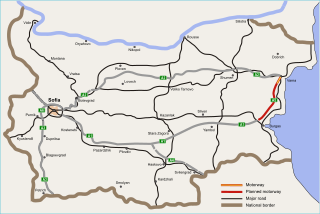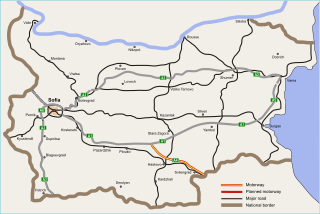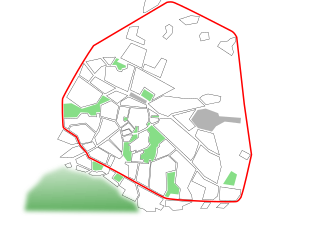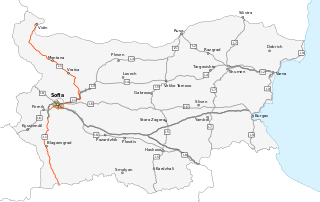
Sofia Airport is the main international airport of Bulgaria, located 10 km (6.2 mi) east of the centre of the capital Sofia. In 2019 the airport surpassed 7 million passengers for the first time. The airport serves as the home base for BH Air, Bulgaria Air, European Air Charter and GullivAir, and as a base for both Ryanair and Wizz Air. The airport also houses the Bulgarian Air Force's Vrazhdebna Air Base.

The Sofia Metro is the rapid transit network servicing the Bulgarian capital city Sofia. It is the only metro in Bulgaria. It began operation on 28 January 1998. As of 2024, the Sofia Metro consists of four interconnected lines, serving 47 stations, with a total route length of 52.0 kilometres (32.3 mi) and also being among the top 20 of the most extensive European metro systems, ranking 14th as of 2023. The Metro links the densely populated districts of Lyulin – Mladost and Nadezhda – Lozenets, and serves the Sofia Airport.

Kresna Gorge is a steep valley in south-western Bulgaria, stretching about 18 km (11 mi). The gorge has been formed by the Struma River, which flows from the Vitosha mountains. Kresna gorge has a rich biodiversity, which has come under pressure from the Struma motorway construction project, a new leg of the Trans European Corridor No. 4. In the south, the gorge bisects the Tisata nature reserve.

European route E 79 is a road part of the International E-road network. It begins in Miskolc, Hungary and ends in Thessaloniki, Greece, also running through Romania and Bulgaria. The road is 1,300 km (810 mi) long.

The Hemus motorway or Haemus motorway, designated A2, is a partially built motorway in Bulgaria. Its planned length is 418 km, of which 191 km are in operation as of October 2022. The motorway in operation is divided into two sections — the first one links the capital Sofia with Boaza near Yablanitsa, crossing Stara planina, and the second segment connects Varna and Buhovtsi near Targovishte. According to the plans, Hemus motorway would connect Sofia with the third-largest city of Varna, at the Black Sea coast, duplicating European route E70 (Varna–Shumen), European route E772 (Shumen–Yablanitsa) and European route E83 (Yablanitsa–Sofia).

The Cherno More motorway or the Black Sea motorway is a Bulgarian motorway planned to link the major coastal cities of Varna and Burgas, passing along the Bulgarian Black Sea Coast. It is part of the Pan-European Corridor VIII and is estimated to be 103 km long when finished. As of 2016, 10 km of the motorway are completed, from the Asparuhov bridge in Varna to the village of Priseltsi.

The Struma Motorway is a motorway currently under construction in Bulgaria. The motorway is located in the Yugozapaden area in South West Bulgaria, and follows the route Sofia-Pernik-Dupnitsa-Blagoevgrad-Sandanski to Kulata on the border with in Greece. It is part of the Pan-European Corridor IV and also is part of Е79, that runs from Miskolc (Hungary) to Thessaloniki (Greece), via the Romanian cities of Deva and Craiova. This project is under the European Union's Ten-T Priority Projects. The road is also part of the proposed Via Carpatia route.

The Maritsa motorway, designated A4, is a motorway in Bulgaria, part of the Pan-European Corridor IV, between the Trakia motorway (A1), at the town of Chirpan, and Kapitan Andreevo, at the Turkish border.

The Sofia ring road, also called in Bulgarian Okolovrástnoto shosé, often shortened to just Okolovrástnoto is an important thoroughfare surrounding Sofia, the capital of Bulgaria. The ring road is 61.8 km long and has recently been upgraded on several sections, with plans to further improve it on the remaining sections.

The New Europe Bridge, also known as Danube Bridge 2 is a road and rail bridge between the cities of Vidin, Bulgaria, and Calafat, Romania. It is the second bridge on the shared section of the Danube between the two countries. It is an extradosed bridge and was built by the Spanish company Fomento de Construcciones y Contratas, at the cost of €226 million. It was officially opened with a ceremony held on 14 June 2013. The first vehicles were allowed to cross the bridge after midnight, on 15 June 2013.

Krum Georgiev Bibishkov is a Bulgarian former footballer and football manager.

Knyaginya Maria Luiza Metro Station is the 21st station to open on the Sofia Metro in Bulgaria. It is situated near the Nadezhda road junction in the northern part of Sofia, at the intersection of Maria Luiza Boulevard and Gen. Stoletov Blvd. It opened on 31 August 2012 and is also known as the fifth station on the M2 line of the metro. It was also the first station on the path of the TBM, which worked on the section between stations 5-II and 9-II, entirely constructed by the Turkish company Doğuş Construction, part of Doğuş Holding. The station is a shallow triple-span station with two rows of concrete and steel columns. It serves two central tracks and two side platforms. There are four street entrances, two on each side of the boulevard after which the station is named. They lead to a central vestibule, directly above the station.
Highways in Bulgaria are dual carriageways, grade separated with controlled-access, designed for high speeds. In 2012, legislation amendments defined two types of highways: motorways and expressways. The main differences are that motorways have emergency lanes and the maximum allowed speed limit is 140 km/h (87 mph), while expressways do not and the speed limit is 120 km/h (75 mph). As of October 2023, a total of 879,1 kilometers of motorways are in service.

The Europe motorway, designated A6, is a motorway that will link the Bulgarian capital Sofia with Serbia at the Kalotina border crossing. Spanning approximately 64.15 kilometers (39.86 mi), the motorway is planned to be connected with the Serbian A4 motorway.

The Vidin-Botevgrad expressway is a planned expressway in Bulgaria, that will link the A2 Hemus motorway with Vidin and the New Europe Bridge, at the Danube border crossing to Romania. The expressway shall provide grade-separated dual carriageway with two lanes in each direction and it shall replace or supersede the existing I-1 road.

Republic road I-1 is a major road in western Bulgaria. It runs between the New Europe Bridge, at the Danube border with Romania, and the village of Kulata, at the border crossing to Greece. The total length of the road is 453.8 km (282.0 mi). Most of it provides one driving lane per direction and it is planned to be superseded or replaced in all sections by either motorways, or expressways.

Republic road I-5 is a major road in central Bulgaria. It runs between Danube Bridge, at the Danube border with Romania, and the Makaza pass, at the border crossing to Greece. The total length of the road is 397.3 km (246.9 mi). Most of it provides one driving lane per direction. Road I-5 follows European route E85 from Ruse to Haskovo.
The 1904 Kresna earthquakes occurred on the same day of April 4 in the Kresna region, Bulgaria). The pair of earthquakes measured 6.9 and 7.2 on the surface wave magnitude scale, and were assigned the respective Modified Mercalli intensity scale ratings of X (Extreme) and XI (Extreme). More than 200 people were killed in the two earthquakes. Several villages were obliterated as a result.
The Zheleznitsa Tunnel is a 2-kilometre (1.2 mi) highway twin tunnel on the Struma motorway in Blagoevgrad Province, southwestern Bulgaria. It is the longest road tunnel in Bulgaria. The tunnel is named after the village of Zheleznitsa, which it bypasses between the towns of Blagoevgrad and Simitli.
















